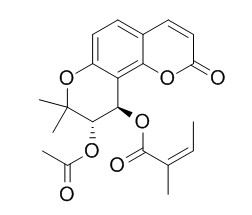Peucedanocoumarin II
Peucedanocoumarin II shows only partial relaxation.
Inquire / Order:
manager@chemfaces.com
Technical Inquiries:
service@chemfaces.com
Tel:
+86-27-84237783
Fax:
+86-27-84254680
Address:
1 Building, No. 83, CheCheng Rd., Wuhan Economic and Technological Development Zone, Wuhan, Hubei 430056, PRC
Providing storage is as stated on the product vial and the vial is kept tightly sealed, the product can be stored for up to
24 months(2-8C).
Wherever possible, you should prepare and use solutions on the same day. However, if you need to make up stock solutions in advance, we recommend that you store the solution as aliquots in tightly sealed vials at -20C. Generally, these will be useable for up to two weeks. Before use, and prior to opening the vial we recommend that you allow your product to equilibrate to room temperature for at least 1 hour.
Need more advice on solubility, usage and handling? Please email to: service@chemfaces.com
The packaging of the product may have turned upside down during transportation, resulting in the natural compounds adhering to the neck or cap of the vial. take the vial out of its packaging and gently shake to let the compounds fall to the bottom of the vial. for liquid products, centrifuge at 200-500 RPM to gather the liquid at the bottom of the vial. try to avoid loss or contamination during handling.
J Biol Chem.2021, 297(6):101362.
The Malaysian journal of pathology2019, 41(3):243-251
Plants (Basel).2023, 12(5):1120.
LWT2021, 150:112021.
Appl. Sci.2022, 12(17), 8646.
J Cell Mol Med . 2023, jcmm.17954.
Molecules.2020, 25(3):734
Nat Prod Sci.2018, 24(2):109-114
Oxid Med Cell Longev.2022, 2022:9139338.
Vietnam Journal of Food Control.2022, 5(2): 115-128.
Related and Featured Products
Biol Pharm Bull. 1999 Sep;22(9):984-7.
Relaxant effects of pyranocoumarin compounds isolated from a Chinese medical plant, Bai-Hua Qian-Hu, on isolated rabbit tracheas and pulmonary arteries.[Pubmed:
10513627 ]
Qian-Hu is a well-known traditional Chinese medicine used for the treatment of respiratory diseases and pulmonary hypertension.
METHODS AND RESULTS:
We compared the relaxant effects of pyranocoumarin compounds, including (+)-praeruptorin A (Pra-C), Pd-Ia (=(+/-)-praeruptorin A), pteryxin, Peucedanocoumarin II (P-II) and 8-methoxy-psoralen (8-MOP) purified from Bai-Hua Qian-Hu (BQ) in isolated rabbit tracheas and pulmonary arteries. Pra-C, pteryxin and Pd-Ia produced significant relaxant effects in tracheal preparations constricted with 40 mM KCl or 10 microM acetylcholine. The relaxant response to Pra-C, pteryxin or Pd-Ia in preparations constricted with KCl was significantly more potent than that in preparations constricted with acetylcholine. Pra-C, pteryxin or Pd-Ia at a concentration of 30 microM completely relaxed tracheas constricted with 40 mM KCl, whereas P-II at the same concentration showed only partial relaxation. In pulmonary arterial preparations, 8-MOP produced a significant relaxant effect on contractions by 10 microM phenylephrine, without any effect on the contraction by 40 mM KCl.
CONCLUSIONS:
These results suggest that Pd-Ia, pteryxin and Pra-C for their calcium antagonistic action, and 8-MOP for its inhibitory effect on contraction induced by phenylephrine, may be the active principles of BQ for relaxing the smooth muscle of tracheas and pulmonary arteries, and the principle may produce a synergistic effect.



